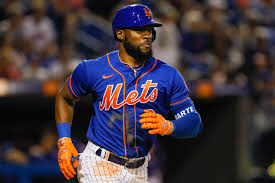Through the first 10 games of the season, the Mets offense was inconsistent at best. Then Carlos Mendoza played with the batting order, and the bats seem to have come alive.
One of the effects of baseball’s evolving outlook on statistics this century has been the re-prioritization of where a team’s best hitters bat in the lineup. Players who may have been automatically penciled in at the third spot, or even batting cleanup, are now batting second or sometimes even leading off. Apparently, there are metrics to validate this approach. However, that doesn’t mean it works for everyone.
The Mets opened the season looking relatively lackluster at the plate. For the most part, they weren’t hitting, especially their “best” players. After losing their first 5 games of the season, the Mets started to show some life when they went on the road to Cincinnati and took two of three games from the Reds. They followed that up with a wild come-from-behind victory over the Braves in Atlanta. Still, something was off. Francisco Lindor, considered by many to be the team’s best overall hitter, was looking anything but. He had been batting second in the lineup in almost each game up to that point, and he just wasn’t producing. Mets manager Carlos Mendoza recognized that in order to sustain their recent winning ways over a longer period of time, Lindor would need to get going. Furthermore, Mendoza seemed to know that in order to get Lindor going, he would need to make a change. Up came Starling Marte.
A quick refresher for those who may have forgotten…the Mets signed Marte prior to the 2022 season. In his first year with the team, Marte batted .292 with an .814 OPS over 118 games. While he was unable to complete avoid the injury bug, he was an important part of that seasons 101-win team. Last season, however, the veteran outfielder started out hurt and never seemed to fully heal. He ended up playing just over half a season (86 games) and was barely a contributor to the team. Many who cover the Mets identified Marte’s need to have a bounceback season in 2024 as a key factor in the Mets potential success. When Marte’s early-season relative success seemed to not have much of an impact on the team’s outcomes, it became apparent that he wasn’t being utilized optimally. And then came the switch.
Beginning on April 9th, in the second game of the Mets series in Atlanta, Marte became the team’s #2 hitter, with Lindor batting right behind him. Marte went 1-5 with an RBI in the Mets 6-5 loss to the Braves that night. Since then, the Mets have gone 8-1, with Marte batting second in each game. Over this 10-game stretch, Marte has batted .292, with 3 home runs, 9 runs scored, 10 RBIs, and 3 stolen bases.
Of course, this updated approach wasn’t just done for Marte’s benefit. In the first 10 games of the season, the Mets were averaging 3.3 runs per game, had been shutout once and held to a single run three times. Over the last 10 games, they have been averaging 6.9 runs per game which includes a 16-run output as well as 2 separate 9-run games.
And what about Lindor? Well, his progress wasn’t instant. It took until the series against the Pirates for Lindor to consistently hit the ball solidly, and only this past weekend in Los Angeles did he really start significantly contributing to the Mets wins.
As the story goes, when the Mets first signed Marte in December of 2021, then-manager Buck Showalter reached out to let him know that his outfield position and place in the batting order were up for discussion, to which Marte suggested that he would play and bat anywhere as long as his spots remained consistent. Time will tell if Marte’s role in the #2 place in the lineup will remain. Injuries, hot and cold streaks, and specific matchups keep lineups somewhat fluid. For now though, between Starling Marte’s increased production and the team’s re-energized offense (and subsequent winning), it appears that Marte’s role is here to stay. And so far, the Mets are better off for that.

